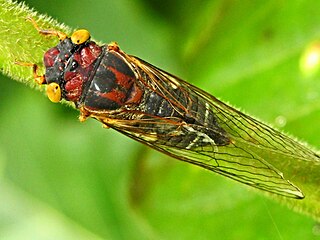
Cicadidae, the true cicadas, is one of two families of cicadas, containing almost all living cicada species with more than 3,200 species worldwide.

The Cicadinae are a subfamily of cicadas, containing the translucent cicadas. They are robust cicadas and many have gaudy colors, but they generally lack the butterfly-like opaque wing markings found in many species of the related Tibiceninae.

Tosenini is a tribe of cicadas in the family Cicadidae. There are at least 10 described species in Tosenini, found in the Palearctic and Indomalaya.

Cryptotympanini is a tribe of cicadas in the family Cicadidae. They are found in the Nearctic, Palearctic, Indomalaya, Oceania, and Afrotropics.

The Fidicinini are a tribe of cicadas. There are at least 20 genera and 250 described species in Fidicinini, found in the Nearctic and Palearctic.

Zammara is a genus of cicadas. These species are large cicadas that are generally bright blue-green in color. Like other cicadas, these can produce loud calls; Zammara tympanum, for example, makes a "winding up-like pulsating buzz." Zammara are found in the Neotropics, especially in equatorial regions, where they live in tropical forest habitat. The genus is characterized by tarsi that are divided into 2 segments, or tarsomeres; other genera in the tribe have 3 tarsomeres in each tarsus.

Cicadettinae is a subfamily of cicadas in the family Cicadidae. About 230 genera and 1,200 described species are placed in the Cicadettinae.

Carinetini is a tribe of cicadas in the family Cicadidae, found in the neotropics. There are about 7 genera and at least 90 described species in Carinetini.

Chlorocystini is a tribe of cicadas in the family Cicadidae. There are at least 20 genera and 170 described species in Chlorocystini.

Cicadettini is a tribe of cicadas in the family Cicadidae. There are at least 110 genera and 520 described species in Cicadettini, found worldwide except for the Neotropics.
Hemidictyini is a tribe of cicadas in the family Cicadidae, found in the Neotropics and tropical Africa. There are at least two genera and two described species in Hemidictyini.

Lamotialnini is a tribe of cicadas in the family Cicadidae. There are about 19 genera and at least 90 described species in Lamotialnini, occurring worldwide except South America.
Parnisini is a tribe of cicadas in the family Cicadidae. There are more than 20 genera and 80 described species in Parnisini, found in the Neotropics, Palearctic, tropical Africa and Madagascar.
Pictilini is a tribe of cicadas in the family Cicadidae, found in Australia. There are at least two genera and two described species in Pictilini.
Prasiini is a tribe of cicadas in the family Cicadidae. There are about 9 genera and at least 50 described species in Prasiini, found in tropical Africa, Australasia, and the Neotropics.
Taphurini is a tribe of cicadas in the family Cicadidae, found in the neotropics.

Leptopsaltriini is a tribe of cicadas in the family Cicadidae. There are at least 200 described species in Leptopsaltriini, found in the Palearctic, Nearctic, and Indomalaya.
Tettigomyiini is a tribe of cicadas in the family Cicadidae, found in Africa and Madagascar. There are about 8 genera and at least 60 described species in Tettigomyiini.

Tettigadini is a tribe of cicadas in the family Cicadidae. There are about 11 genera and at least 50 described species in Tettigadini, found in the Neotropics.
Tibicinini is a tribe of cicadas in the family Cicadidae. There are about 8 genera and at least 100 described species in Tibicinini, found in the Holarctic.














